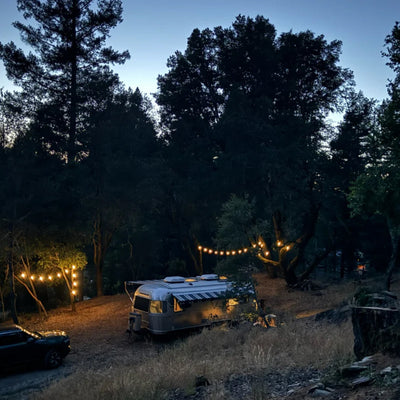What’s the fuss about suspended treehouses? It’s the mix of adventure and comfort—think plush beds in a pod dangling from trees, insulated against the chill, all while dodging ground-level hassles like flooding or wildlife. They’re eco-conscious too, often using minimal materials and no foundations, preserving the forest below. Airbnb treehouses like these consistently rank among the platform’s most-wishlisted stays, with hosts reporting 70-80% occupancy in peak seasons. Spherical treehouses, in particular, amp up the wow-factor, turning a night in the trees into a bucket-list thrill that guests can’t stop raving about.
1. Pinecone Treehouse by O2 Treehouse
-
What It Is: A geodesic, pinecone-shaped marvel suspended 30-50 feet off the ground in Bonny Doon, California, near Santa Cruz—crafted by O2 Treehouse.

- Construction: Weighing 5.5 tons, it’s a steel-and-wood frame hung from five redwood trees with cables, featuring 56 laser-cut diamond panels and a wooden catwalk to an off-grid bathroom. Built in 2017 for a corporate campaign, it’s now an Airbnb rental.
- Where to Stay: Bookable on Airbnb in Bonny Doon—near lavender farms and wineries—for $400-$500/night.
- Cost to Buy: Starts at $150,000+, per O2 Treehouse, varying with installation site—pricey but a one-of-a-kind retreat.
- Comparison: Heavier and costlier than others here, its scale and transparent floor panels offer a surreal float—less portable but unmatched in grandeur.
Pictured: Jon and Jason from Tree Tents visiting the Pinecone Treehouse in Santa Cruz County—where Tree Tents' USA is headquartered.

2. The Tree Tent by, well, Tree Tents!
- What It Is: The Tree Tent from Tree Tents, a 10-foot-wide, weatherproof pod suspended between three trees—a tent-treehouse hybrid that launched the brand. But let's set the record straight: This hanging glamping pod is more of a tiny hanging cabin than a tent.
- Construction: Handcrafted in the UK, and now available in the USA, it's constructed with sustainably sourced plywood, recycled aluminum, and marine-grade canvas, it’s lightweight (under 1,000 lbs) and rigs up in a day with straps, no nails or foundation. Insulation keeps it cozy year-round.
- Where to Stay: Available for purchase ($32,000+), hosts have come up with a variety of ways and settings to install them. They'd be a great fit for Oregon’s Willamette Valley or Tennessee’s Smokies—ideal for wooded glamping sites where you'd like to bring your guests to the trees. Want to stay in one now? Check out the redwood grove stay at Breathing Trees in Santa Cruz County.
-
Rental Average: $250-$400/month on Airbnb, with high demand (75%+ occupancy) due to its rarity and treetop perch.
- Cost to Buy: Starts at $32,000, per Tree Tents’ site—affordable and quick to deploy. You'll have the Tree Tent strung up in your redwood grove in a couple days, three tops. Bonus: The Tree Tent is shipped to you as a kit, ready to be self-assembled. Outside of hiring a tree climber, the installation can be close to free if you're up to the task.
- Comparison: Lighter and more affordable than the Pinecone and many others, it offers a very similar experience, it’s portable and low-impact—a glamping gem that beats grounded counterparts for adventure. The engineering and craftsmanship is hard to beat at such a low cost as treehouses go.
3. O2 Treewalkers Treehouse
- What It Is: A modular, suspended treehouse tent from O2 Treehouse, launched in 2020 as a franchise model for Airbnb hosts.
- Construction: A wooden platform (500-700 lbs) hangs from trees with straps, topped by a canvas roof—assembled in 4-6 days. Minimalist, with a round bed space and no built-in plumbing (portable options available).
- Where to Stay: Sold for $50,000+ via o2's Treewalkers website, installed in U.S. spots like Idaho’s panhandle or Washington’s Snoqualmie Valley.

- Rental Average: $200-$500/month on Airbnb (60-70% occupancy), per Tiny House Talk and social media estimates.
- Cost to Buy: Starts at $50,000+, per O2 Treehouse—not as affordable as the Tree Tent, but still fairly budget-friendly for glamping entrepreneurs that are looking for a different style. However, plan on another $20-40k for installation alone.

- Comparison: Simpler and cheaper than the Fuselage (more on that later), it’s less luxurious but more DIY-friendly—great for budget glampers vs. Free Spirit’s polish.
4. Free Spirit Spheres
- What It Is: Spherical treehouses (Eve, Eryn, Luna) suspended 10-14 feet up in Vancouver Island’s rainforest, Qualicum Beach, British Columbia—pioneers in spherical design.

- Construction: Handmade with yellow cedar, Sitka spruce, or fiberglass, each 9-10-foot sphere (200-300 lbs) hangs from three trees via ropes, mimicking sailboat rigging. Interiors boast beds, galley areas, and insulation; bathrooms are ground-level.
- Where to Stay: Rentable at freespiritspheres.com for $200-$375/night, with plans for California expansion.

- Cost to Buy: Estimated $150,000-$200,000 (based on custom sphere costs from forums on the web)—not sold direct but reflects build complexity.
- Comparison: Lighter than the Pinecone, their biomimicry blends with nature—smaller than the Fuselage but with unique spherical appeal.
5. Nido Treehouse by Treehouse CR
- What It Is: A 7-meter-high suspended retreat in Slovakia’s Babi Lom forest, built by Treehouse CR, the region’s first treehouse firm.
- Construction: A wooden frame (800-1,000 lbs) with a shingled roof, hung from trees with cables—no foundation. Features a bed, small deck, and insulation; bathroom’s ground-level.
- Where to Stay: Rentable in Slovakia (not U.S.-based), but similar designs are popping up stateside—for $200-$350/night.
- Rental Average: $600-$900/month (70% occupancy), based on European glamping trends.
- Cost to Build: Unavailable, but estimated $50,000-$100,000 (per glamping forum estimates for similar custom builds)—mid-range for suspension.
- Comparison: Rustic like the Tree Tent but less portable and labor intensive, its ladder entry adds adventure Free Spirit skips with stairs.
6. The Fuselage by Tree Tents
- What It Is: The Fuselage, a 15-foot cabin-like pod engineered for suspension (though often stilted), offering a sleek, aluminum-clad alternative. And you heard that right—you can hang this bad boy in the trees!
- Construction: Built with recycled aluminum and sustainable wood, it’s suspended via straps or cables from trees or a frame, weighing ~1,200 lbs. No foundation needed, with insulation for all seasons.
- Where to Stay: Spotted at Breathing Trees Camp in Northern California, it’s for sale on the Tree Tents website ($48,000-$75,000) and fits U.S. forests like Colorado’s Rockies or New York’s Adirondacks.
- Rental Average: $250-$400/night at 250 nights/year, outpacing many others at 80% occupancy.
- Cost to Buy: $48,000-$75,000, per Tree Tents—higher than Tree Tent but versatile.
- Comparison: More durable than canvas tents, its suspension dodges zoning woes with a modern-meets-retro twist grounded pods can’t match.
Which One’s the Greenest?
Sustainability matters in glamping, and these treehouses vary in eco-impact. The Pinecone’s 5.5-ton steel frame and heavy cables demand more resources and tree stress, while Free Spirit Spheres lean greener with light cedar/fiberglass (200-300 lbs) and rope suspension—though their small size limits scalability. O2 Treewalkers (500-700 lbs) and Nido (800-1,000 lbs) use modest wood and straps, but their canvas or shingle roofs might contribute to waste over time. The Tree Tent and Fuselage stand out as the eco-champs: the Tree Tent’s under-1,000-lb build with recycled aluminum and canvas minimizes material use, and the Fuselage’s 1,200-lb frame pairs recycled aluminum with sustainable wood—both strap-suspended, foundation-free, and low-impact. No evidence suggests otherwise; their lightweight, reusable designs make them the greenest picks for glamping hosts who care about the planet.
Why They’re Worth It
Suspended treehouses like these aren’t just glamping—they’re a lifestyle. The Pinecone and Free Spirit Spheres deliver jaw-dropping designs with premium rates, while the Tree Tent and Fuselage offer U.S. hosts flexibility, high-rates, no-brainer ROIs, and a luxurious eco-appeal. The all have the rustic charm still pull crowds. Construction varies—light straps vs. heavy cables with different ways of attaching to the trees—but all skip foundations, easing permits. If you'd like to chat about our line of eco-structures - well, get in touch!















